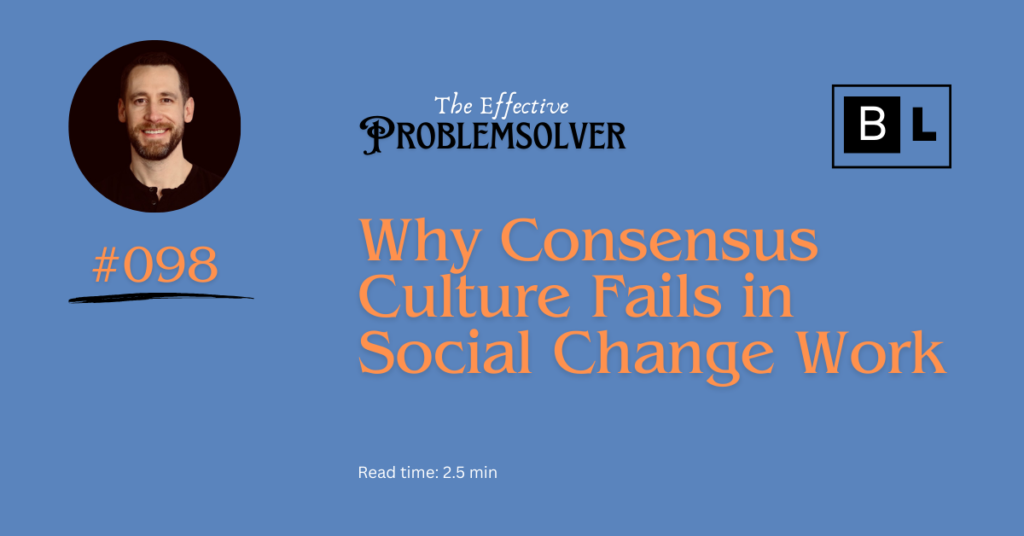THE EFFECTIVE PROBLEMSOLVER #098
A few years ago, I coached the director of a regional collaborative working on economic development.
She was sharp—big-picture thinker, good instincts, deeply respected.
But something wasn’t working.
Despite 50-hour workweeks, regular community convenings, and lots of partner engagement, there had been no meaningful results after nearly two years.
No new policies. No pilot projects. No real movement.
She knew it, too.
When we dug into what was going on, she admitted,
“I don’t make a move without checking in with everyone—staff, board, partners. I’m trying to make sure people feel heard. But I think I’m actually avoiding doing the hard stuff.”
She wasn’t failing because she lacked good ideas.
Quite the opposite—she had several strong policy and implementation proposals.
But each one got run through the same slow, exhausting process: workshops, subcommittees, async edits, inclusive feedback cycles, follow-up meetings to process that feedback, and watered-down revisions that tried to satisfy everyone.
In the end, nothing moved. And no one was really satisfied.
Collaboration Is Not the Highest Goal
In the social sector, there’s a deeply held belief that collaboration is always better.
It’s the air we breathe.
“If you want to go fast, go alone. If you want to go far, go together.”
Sure. But let’s be real.
That quote is about the long arc of a big journey. It’s not about how to write a memo, draft a strategy, or implement a pilot.
When we treat every task as if it requires consensus and co-ownership, we end up with:
- Meeting agendas that try to satisfy all parties and satisfy no one.
- Reports written by committee that say nothing clearly.
- And maybe my favorite: “Let’s not take a position yet—we need more alignment.”
Alignment is great, but you can’t steer a parked car.
A Better Way: Directly Responsible Individuals (DRIs)
In high-functioning organizations—whether Apple or a scrappy nonprofit startup—important tasks are assigned to a DRI: a Directly Responsible Individual.
This person doesn’t go rogue, but they do own the outcome.
They’re accountable.
They decide what feedback to incorporate, how to balance speed and quality, and when to move.
More importantly, everyone else agrees that the DRI is in charge of that decision.
That’s their role.
Silly (But Familiar) Examples of Over-Collaboration
Let’s poke at this a little with some common social sector scenarios:
- The mission statement that took six months, 40 people, and a whiteboard retreat—only to end up with “We work together to co-create equitable thriving communities of mutual flourishing and belonging.” Huh?
- The logic model where six organizations each inserted their pet activities, making it 11 pages long—everything together ends up meaning nothing.
- The community dashboard with 37 indicators, 9 user personas, and a “community engagement strategy” that took longer to build than the dashboard itself. And guess what – a year later no one ever uses it.
We’ve all been in these rooms.
They make for great donuts and good feelings—just not actual change.
What to Do Instead
Working collaboratively doesn’t mean doing everything together.
It means knowing which things require collaboration—and which don’t.
Here are three practical steps to reclaim your effectiveness:
- Clarify roles with intention.
Every task should have one DRI. That person can and should gather input, but they make the final call. Define who owns what, and say it out loud. - Differentiate between co-creation and consultation.
Not everything needs to be co-designed. Decide which decisions are better made through leadership, and which ones truly benefit from collaboration. Hint: Most things don’t require full consensus. - Start small with DRI.
Pick one initiative you’re leading. Assign DRIs for the core deliverables. Let people know who’s in charge. Then back them. You’ll be surprised how fast things start moving.
You don’t need to choose between being collaborative and being effective.
But you do need to choose when to lead and when to convene.
Sometimes the most respectful thing you can do is say: “I’ve got this.”
Because the goal isn’t harmony. It’s progress.
See you in two weeks.



